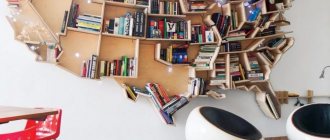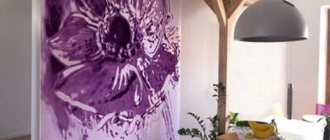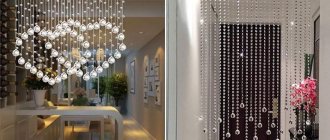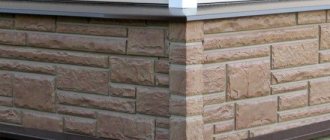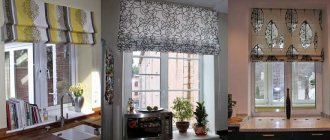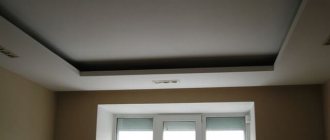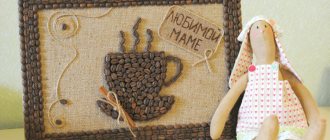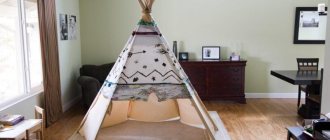Original do-it-yourself wall painting
Even with minimal artistic talents, nothing can stop a person from feeling like a creator. Especially in cases where you want to decorate your own home yourself, using your imagination.
The author's technique is very popular. Simple to perform and original in results, the technique is based on the use of water-based paints and a few simple sponges. A sketch is drawn onto a wall covered with white vinyl wallpaper using a simple soft pencil. The edge of a sponge soaked in water is dipped into the desired paint, after which the coloring composition is spread over a specific area with light strokes. Often, several different shades can be used to paint one area.
There are unspoken rules according to which certain topics are considered unacceptable for certain premises. For example, in the kitchen it is undesirable to paint images that could negatively affect the appetite of the household. Drawings of dried leaves and wilted flowers are inappropriate in the bedroom. Also, in a room where a person should relax and be able to sleep peacefully, there should be no images of waterfalls and the depths of the sea.
We stock up on the necessary materials
The canvas for wall painting is a flat wall of uniform color. If the renovation of the room has been completed recently, then you can start drawing. In other cases, it is better to partially or completely renew the coating. The following steps are included in the preparation of walls:
• leveling the surface using drywall or plaster; • starting putty; • finishing putty; • coloring in the background tone.
Plaster or gypsum board, as well as all types of putty, should be primed, otherwise cracks may appear on the wall. It is better to purchase primer and paint from the same manufacturer. Then you can proceed directly to painting.
Complex drawings are best left to professionals
For artwork you will need the following materials.
• Paints. For wall painting, the best choice is water-based acrylic matte paints: they dry quickly and have a neutral odor. Acrylic mixes easily and fits well on the surface of the walls, without smearing from accidental touch, unlike gouache. Suitable paint consistency for wall painting: low-fat sour cream.
It is not at all necessary to buy a full palette of colors: the desired shade is obtained by mixing others. For example, to make a color lighter, white is added to it, and darker - dark gray. Mixing any acrylic-based paints with each other is allowed. You can also give acrylic the desired tone using universal colors, adding them by eye.
If you want non-trivial solutions, pay attention to acrylic with luminescent and fluorescent additives. But such exoticism in a living space quickly gets boring
Interesting visual effects are obtained through the use of pearlescent or metallized acrylic. There are also special acrylic paints for airbrushing in cans.
Bright acrylic painting
Painting walls with oil paints is rather a relic of the past. Working with them, from mixing to application, requires special skills. Oil, unlike acrylic, is considered a capricious material, prone to fading and darkening over time. The peculiarity of oil paints is the long drying process, which allows the artist to adjust the image.
Quite rarely, due to the high cost, tempera-based paints are used for painting walls. Their advantage lies in their excellent covering ability. Thus, using white tempera you can depict a highlight of maximum contrast even on a black background. Mixing acrylic and tempera is allowed. They dry at approximately the same speed.
Multi-colored painting in the living room
• Brushes of different thicknesses, preferably made from pony or squirrel hair. Thin brushes are used for drawing details, thick ones for large areas. Foam rollers are also useful if you need to paint an area with one color. • Interior or facade acrylic varnish: it is used to cover the finished painting in several layers. Such compositions additionally protect the design from negative external factors: sunlight, changes in temperature and humidity, and pollution. • Pencils, felt-tip pens, and markers are used less frequently, mainly for painting small areas of the wall. Depending on the chosen technique, stencils and rollers may be needed.
This painting does not get boring and fits into any interior.
Rules of care
Despite the fact that the materials and the method of their application differ from those used in the Middle Ages, some care for the product will be required.
- First, don't forget to varnish the picture. This will simplify care and allow it to remain fresh for a long time.
- If coating is not part of the plan, use a dry cloth to remove dust.
- Monitor the temperature and humidity of the room.
- If the drawing has smudged, make small corrections with a brush.
- Periodically update the brightness of the image, or change it completely.
In general, when using a protective coating, maintenance is reduced to removing dust from the wall with a damp cloth. The rules of care are quite simple, so you can safely make your dreams come true, creating unrealistic images to your delight and to the envy of your friends.
How to paint a wall yourself in a detailed lesson?
First of all, you need to choose the size of the future image and decide on the drawing itself. For beginners, it is better to choose simple artistic paintings with smooth lines and a minimum of small details - for example, sea and mountain landscapes, images of flowers and trees. To simplify the task, it is better to copy from some ready-made panel.
Next you need to prepare the wall. The ideal option would be to start painting immediately after applying putty and painting the wall. However, if the drawings are made after the apartment has been renovated, you can apply strokes to the old paint.
What tools will you need to paint a wall?
For work we will need paints, brushes, acrylic varnish to cover the finished drawing and a solvent. Special water-based acrylic paints are best - they are opaque and easy to apply. Do not forget about white acrylic paint - it is with its help that you can achieve the required shades. To mix paints and rinse brushes in solvents, you will need disposable utensils. Wider, flat synthetic brushes are suitable for large strokes, and round ones are suitable for drawing out details. The latter are made from natural pile, usually from kolinka fur. To draw flower petals, artists often use a special technique using a foam roller.
The procedure for applying a picture to the wall:
1) Decorative wall painting begins with preparing the background - make sure that the coating on the wall is even and does not require additional painting.
2) Before applying the painting, it is recommended to mark the main details on the wall. You can use stencils to design complex elements.
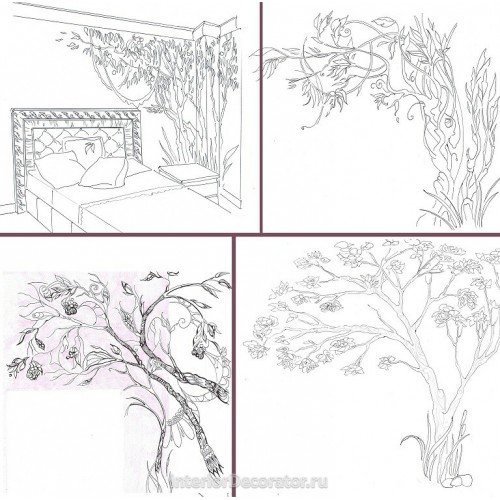
3) When drawing a sketch on the wall, it is better to use colored pencils - they are easier to remove with a soft eraser. A simple pencil can leave unsightly black marks.
4) Now you can start applying paint to the wall. Remember that acrylic paints dry very quickly, so you need to mix colors before decorating. Don't be afraid to apply several layers of strokes, just make sure they dry. After applying the main part of the design with a thin brush, you need to paint small details: sun glare, folds of fabric, tree bark. For inspiration, you can turn on your favorite music.
Painting walls using a stencil does not require any special artistic skills, because... You can simply find the finished drawing on the World Wide Web, print it out and carefully cut it out. Next, you need to place the stencil on the desired location and apply paint, carefully making sure that the stencil does not move anywhere (to do this, it is better to secure it with tape).
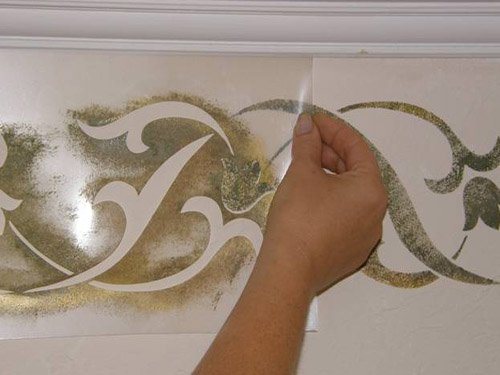
Or you can use a more simplified method. To do this, you need to buy a ready-made stencil at a hardware store and simply stick it on the wall. This pattern can be washed, it looks fresh and modern in the interior and, most importantly, it can be easily removed from any surface. Therefore, if you get tired of the image, you can easily delete it.
Marker drawing on the living room wall
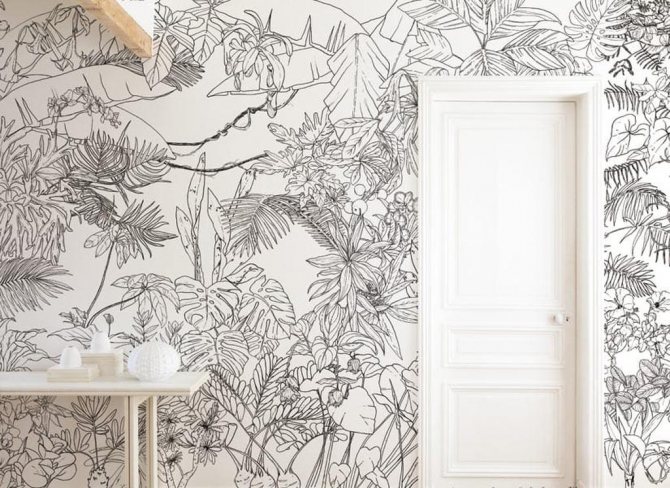
This is a very detailed work, everything is drawn with markers of different thicknesses. With markers you can draw objects in real size and paint the entire wall from floor to ceiling. The price of the work is as in the picture from 3,500 per m2. That is, with a wall length of 5 meters, such work will cost 47,200 rubles

graffiti marker
You need to draw with a graffiti marker. This is a professional tool for painting walls, it covers well, when the paint runs out, the marker can be refilled. There are also many markers to choose from, so there is also freedom in the colors. We even know how to make our own marker refill (paint) and thus make any color.
This is sometimes necessary when the color of the marker needs to match the color of the paint in the can.
How to draw with a marker using a projector
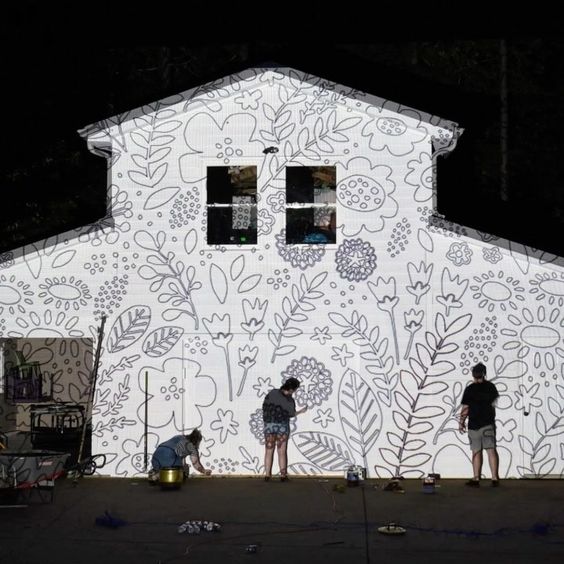
A projector is a handy thing to use for painting. By turning off the light and pointing the sketch at the wall, you can safely transfer the drawing to the living room. It is enough just to darken the room by hanging bags on the windows.
Painting with marker and additional color
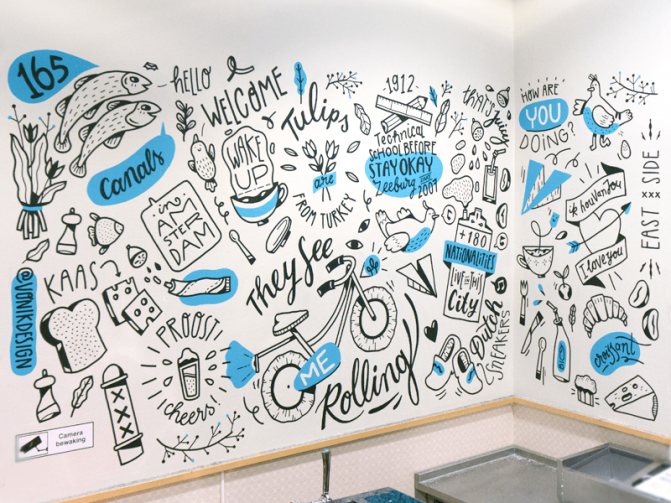
To liven up the painting with markers a little, you can add an additional color. This way the painting will no longer be monotonous, but will sparkle with new colors. You can add multiple colors, but be sure to explore color combinations.
Basic styles of wall painting
- Classic style
. It is always relevant, in demand and not subject to the whims of fashion. The pillars of classicism are simplicity, straightness of form and symmetry, harmony and restraint. Classics are able to organically convey national flavor, combine with non-standard modern materials and elements, without losing their “main line”, aimed at harmony of color and shape. - Baroque style
. It marked the next round in the development of classicism and became the embodiment of its time. The ornaments of this style contain ornate plant motifs: large flowers, tree branches or large leaves. No less in demand are images of half-naked bodies in physical effort, the tension of struggle or strong movement. The interior, designed in the Baroque style, is dominated by a rich play of bright colors, light and shadow, which gives the room luxury and pomp. - Empire style
. It harmoniously combines classical severity with impressive decor. The perception of color here is built on a combination of tones of Bonaparte’s symbolism: gold, purple and blue. The ornaments of the style are found in a combination of their conventional and naturalistic elements. When painting walls in the Empire style, flower garlands and triumphal and pompous wreaths are actively used. Some ornaments are taken from the culture of Egypt, so in the Empire style interior you can see sphinxes, winged lions or griffins. - Art Nouveau style
. It is easily recognized by its growing, living and breathing abstract forms. A characteristic feature of the style is a complex ornamental system with large flowers and curved wavy stems. Sometimes fairy-tale creatures are also depicted in modern art: mermaids, elves, as well as strange plants that form characteristic curved lines. The color scheme of the style is dominated by natural shades. Everything in modernity strives for rationalization and simplification, but without sacrificing elegance. The interior in this style is not distinguished by excesses and manifestations of status, but implies the unobtrusive presence of nature. Art Nouveau is characterized by a harmonious combination of functionality and decor. - Arabic style
. This is not just an interior, but a whole worldview formed under the influence of Islam. The main differences between wall painting in this style are: richness of color, unusual solutions, originality, magical and mysterious atmosphere. The style intricately combines stylized Arabic script, geometric shapes and floral motifs, resulting in bright and sophisticated patterns that are repeated on the walls in a certain rhythm. Thanks to a large number of complex patterns, the walls become like luxurious Arabian carpets. Rooms decorated in this style have a warm and cozy atmosphere. - Anime style
. It originated in Japan and quickly became popular not only in its own country, but also far beyond its borders. Japanese animation characters have become in demand among numerous fans of this genre. Anime style wall painting looks harmonious in Japanese room design. The combination of its functional and laconic forms with bright images of “cartoon” characters can become a source of special pride for any owner. Interior design in this style is ideal for a children's room.
Straight lines on the wall
If your thing is minimalism and perfection, then you will like straight lines. They definitely calm the interior and make the living room unique. Just imagine how cool you can beat a wardrobe, TV and chandelier by setting the lines where you want
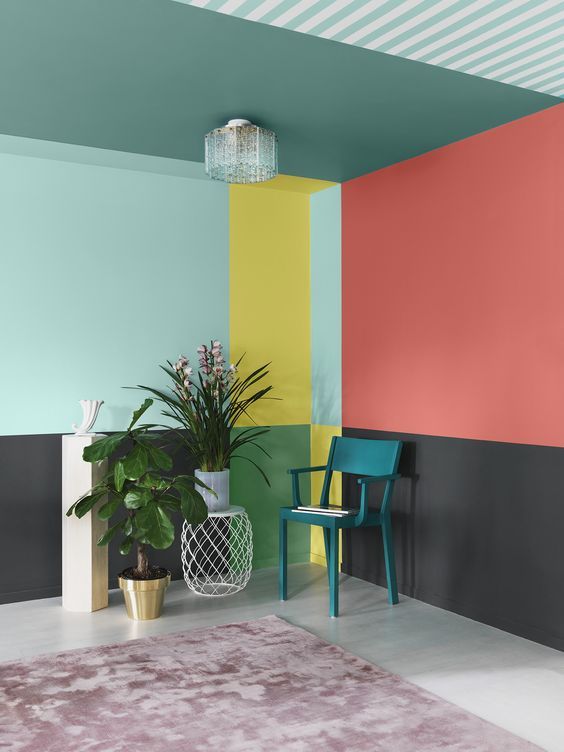
lines in the living room
Using lines you can easily surprise your guests, because drawing them is very simple. All you need is a paint kit, some rollers and a couple of cans of bright, pretty paint. We do this kind of work for 2000 rubles m2. That is, we will make a 3 by 4 wall for 24,000 rubles .
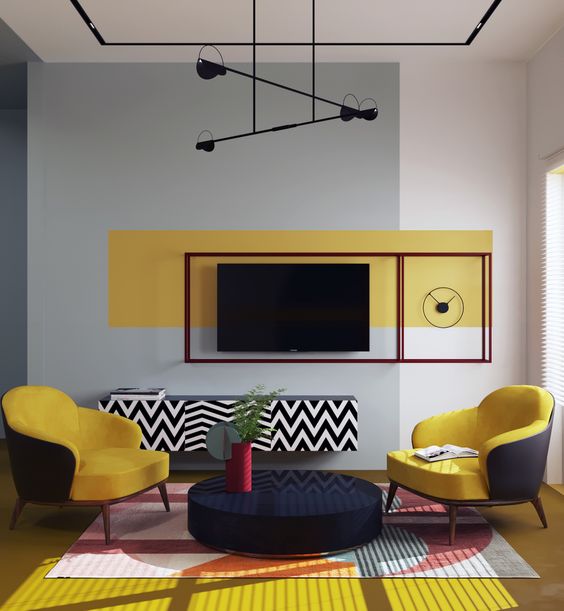
rectangular wall painting
A laser level and a tripod will definitely be useful in your work; this is the only way you can draw perfectly straight lines.
Idea 2. Painting checkered walls (+ master class)
As you know, check is the most versatile print that never goes out of style. It fits perfectly into both classic and modern interiors, both into the interior of the kitchen and children's bedroom. You can decorate one or more walls with a cage using wallpaper or painting.
Painting checkered walls with your own hands is somewhat more difficult than gluing checkered wallpaper, but painting gives a better result: the painted surface can be washed, repainted, and most importantly, it does not have seams that risk peeling off.
The easiest way is to paint walls in a large Vichy checkered pattern, as in this collection of photos.
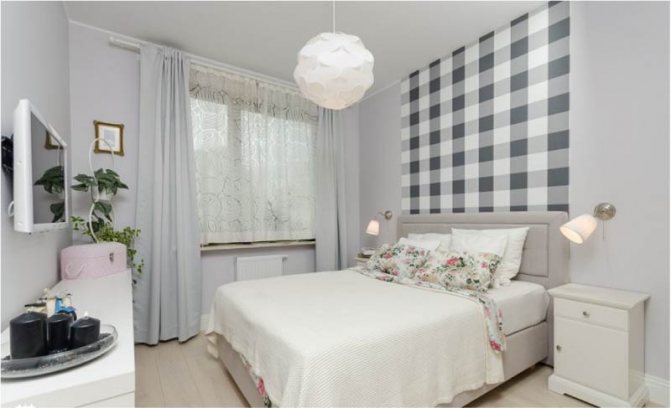
Painting walls in Scottish tartan requires a little more effort, but still, it is accessible even to beginners - after all, the accuracy of the markings, rather than painting skills, is what is important here.
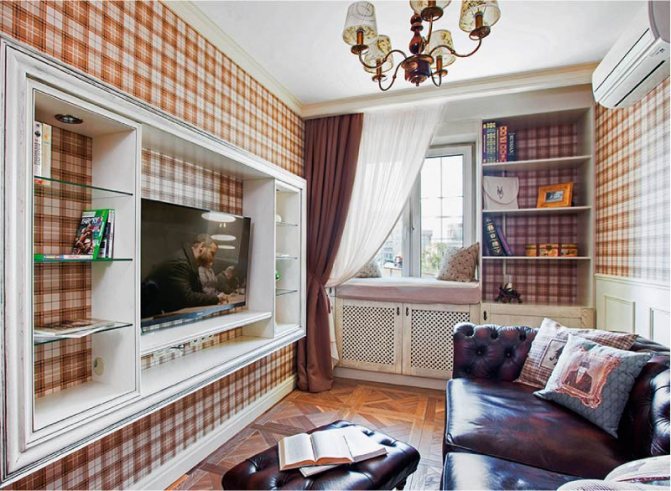
And now we suggest you familiarize yourself with the step-by-step instructions for painting walls with your own hands in tartan, as in the photo below.
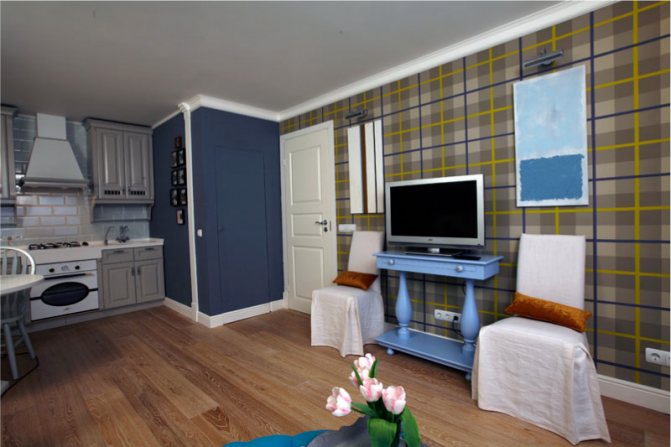
What you will need: 4 paints of the same color, but in different tones (in this project we used light olive for the background, a slightly more saturated marsh shade for vertical and horizontal stripes, an even darker one for the intersections of stripes, as well as two paints of contrasting colors), brushes , roller, masking tape and laser level, stepladder and other basic painting supplies.
It is best to use blue masking tape for painting walls, which can be removed without leaving a trace, without damaging the wall covering, and is marked “for clean lines.”
Instructions:
Step 1: Prepare the wall for painting, then paint it with the background color using a roller. In this master class, the background is a light olive tone of paint. Allow the background layer to dry before moving on to the next step.
Step 2. Mark vertical stripes of equal width on the wall using a laser level and masking tape. Then paint them with a paint darker than the background and let dry.
To ensure that the lines are smooth and clear, and the paint does not flow under the masking tape, use a small brush to paint along the tape and a larger brush to paint the main body of the strip.
It is important to ensure that there is no excess paint on the brush. The movement of the brush should not be up and down along the tape, but left and right (across the tape)
Step 3. Now mark the horizontal stripes in the same way, paint over them and leave to dry.
Step 4. Paint the intersections of the stripes in an even more saturated shade to create the effect of layering threads of the same color in the checkered fabric (as if that made the cells darker than the stripes).
By the way, if you want to paint the walls in a Vichy checkered pattern, then at this stage the work can be considered completed.
Step 5. It's time to draw the contrasting thin stripes that are required for the tartan check.
To do this, again use the laser level and masking tape, mark a line along and in the center of the vertical stripes. Next, paint over them and let dry. Then use the same paint to draw lines along the horizontal thick stripes.
Step 6. Finally, we draw cells of a different contrasting color (in this master class it is blue). The technology is still the same, but the cell becomes larger, since the stripes are drawn along the lines of the first background layer.

Step 7. All that remains is to coat the painted wall(s) with matte varnish to enhance its moisture resistance and strength.

Geometry in the living room
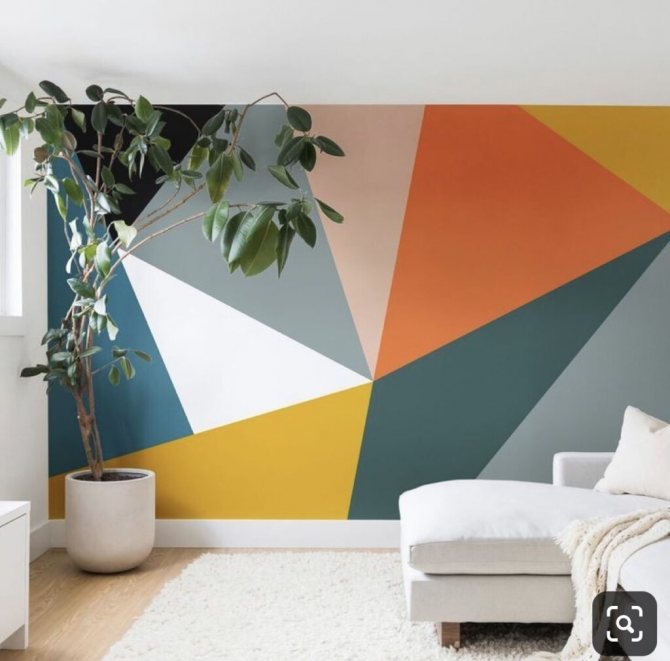
This style never ceases to be popular. Simple lines, lots of colors and straight shading. It may be simple, but it always looks beautiful and interesting. Moreover, such painting of the living room will cost only 1,500 rubles per m2 . For example, if your wall is 5 meters long, then the entire wall will cost 20,250 rubles .
How the work is done
This work is done using tape using rollers and pre-tinted paint. We use Dulux Diamond. On the official website you can immediately select the colors you need and tint them in the store.
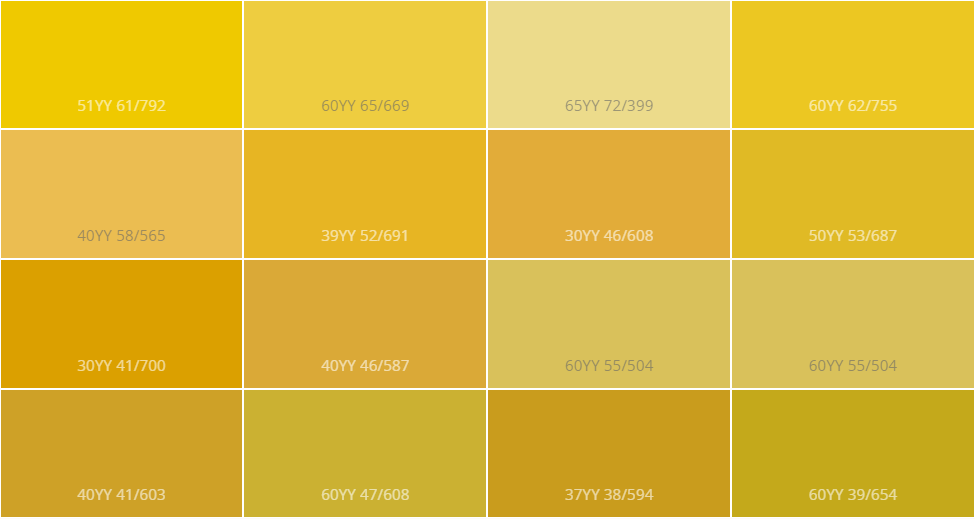
tinting
Geometry sketch
We also make any sketches for painting the walls in the living room, including geometric ones. The price for such a sketch is 3,000 rubles. The price for materials for such work is 4,000 rubles.

sketch
Techniques used to create the painting
Painting can be created in various techniques, among which the most popular and effective are:
- Fresco and alsecco close to it;
- Three-dimensional painting (similar to bas-relief) and sgraffito;
- Airbrush;
- Fluorescent acrylic paintings;
- Grisaille. It will require high skill, as it is performed in one color of different saturation. The technique is similar to graphics.
Separately, it is worth noting the method using stencils. This option is ideal for beginners who are not confident in their abilities and are afraid to put the first touch on the prepared wall.
Brick wallpaper +75 photos in the interior
Airbrush
In this technique, instead of brushes and paints, an airbrush can is used. It sprays the contents over the surface, even its name translates as “drawing with air.” Dyes in airbrushing use liquid and powder, but water-soluble acrylic is more popular. The composition applies to any surface, even wallpaper. You will have to work in a respirator. Few people will be able to master the technique from the first “zilch”. Before painting, you will have to practice to get used to the unusual method. The airbrush allows you to draw even tiny details, thereby providing highly detailed drawings. By the way, even ancient artists used a similar technique, blowing dye from special tubes.
Fresco
The fresco technique has been used for interior decoration since the Middle Ages. The essence of the method is to apply paints to the plaster that has not yet dried. It contains lime, which forms a strong calcium film on the surface of the pattern. The disadvantage of this method is the need to work very quickly. For this reason, it is not recommended to resort to the technique for novice artists who are just mastering the art of painting. Water-soluble paints are used for work.
Painting with fluorescent paints
Fluorescent paints have a special feature - glow in the dark . Use transparent or colored compounds. The first ones are generally invisible during the day, just like the drawing. In the daytime, colored ones look like ordinary paints used for painting, but at night they transform the walls with a pleasant glow. Quite often, drawings made in acrylic or tempera are decorated with fluorescent compounds. They highlight accent elements. The fluorescent composition is absolutely safe for humans; it does not emit toxic substances. These colors are recommended for depicting simple landscapes without an abundance of small details.
Volumetric painting
The volumetric technique combines the process of sculpting with painting. First, plaster or plaster is applied to the prepared surface. Relief elements are formed from the material that has not yet dried. Then, after drying, the “stucco molding” is painted. There is another technique called sgraffito. The method comes from Italy. Several layers of colored plaster are successively applied to the wall. After it dries, they begin to scratch out the design with a special sharp tool. The result is a relief image, which, as practice shows, will last for many years.
Using stencils
Stencils are the best help in situations when the imagination draws fantastic landscapes, but hands cannot replicate them. The device is also used when it is necessary to depict many similar elements in order to reduce work time. Stencils are usually made of plastic. The plates are washed after use and are ready for reuse.
Painting with acrylic paints
Acrylic is considered the most convenient material for beginning designers. Its color “assortment” is rich, and its composition is completely safe for humans. Acrylic can be washed off if necessary if you need to correct individual details of the painting. Gradually, after you start getting better at it, it is recommended to use combinations of techniques to improve your skills.
Interior for a children's room
In the nursery, thanks to wall paintings, you can create a real fairy-tale kingdom.
On the walls in the room there are depictions of a mysterious forest, characters from cartoons and fairy tales. That is why you need to choose light blue, pink, light green or peach tones for decoration.
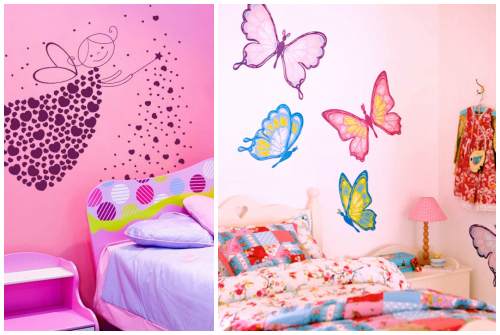
It is better not to choose gray and gloomy shades, as this frightens the baby and does not contribute to his creative development.
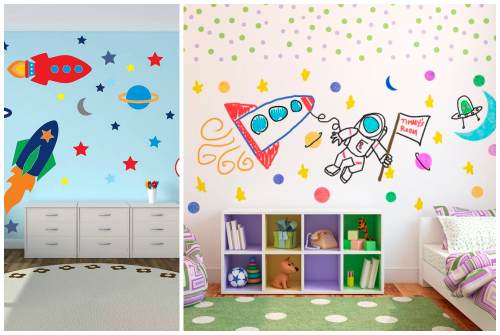
For harmonious development, the baby needs many small details that will attract attention. Alphanumeric combinations on surfaces are relevant for preschoolers
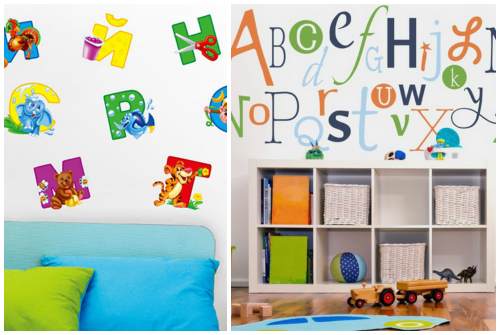
For little girls, it is better to choose fairy-tale characters and princesses, while boys will like technology and pirates. During adolescence, there comes a time when a child becomes interested in comics and anime characters. Take these motives into account when making repairs.
Get ready for the fact that children's interests change very quickly, so it is quite possible that in a year or two you will have to change the decor.
Surface preparation
The first step is to decide which image on which wall will best fit into the design of the room itself.
Then you need to clean the surface of the old coating, be it wallpaper or paint.
Although, some types of paints can be safely applied with plaster. This won't work with just oil paints.

Most often, paintings or frescoes on the wall are made using plaster that has been carefully applied and dried. The stencil technique is possible without this preparation: it can be done directly on the wallpaper. You can also do without cleaning the wall if the room has paintable wallpaper (special types of non-woven, paper or glass wallpaper).
Learn how to paint walls step by step with your own hands, choosing a design
It should be remembered that repairs are not done every day, so the choice of drawings on the walls must be approached responsibly. Most often, colorful images are applied in the children's room, because kids love bright drawings so much. However, do not forget that children's addictions to certain characters usually do not last long and very soon they may ask for a new drawing. In addition, children grow up very quickly and, perhaps, a schoolchild will no longer want to have a room with cartoon pictures.
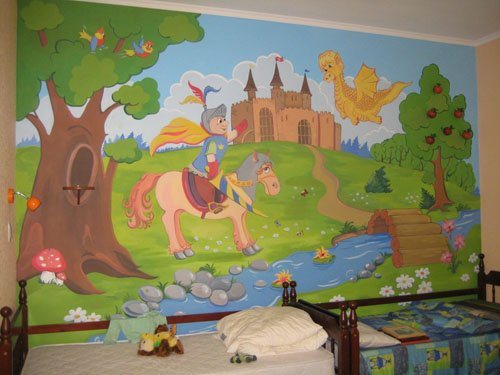
When embodying your wildest ideas, you should take into account the overall design of the room and its intended purpose. For example, soft, calm drawings (landscapes or abstraction) will look better in the bedroom, while a brighter, conceptual image can be placed in the living room. Cityscapes often look good in kitchen interiors, for example, a cozy French cafe or a view of the Bay of Naples.
The photo below shows the interior with hand-painted walls.
Selection of drawing
The choice of subject, colorful materials and image size depend on the room in which the painting will be carried out. It is necessary to take into account the interior, the style of the room, lighting and the tasks assigned to the artist.
Bedroom
This is a place of rest and sleep. When choosing a subject, avoid images with raging elements: waterfalls, stormy rivers, tongues of fire. Wild animals and scenes of fading nature will also be inappropriate.
Calm landscapes and flowering plants, flowers and trees, birds and butterflies, a beautiful sky, a smooth lake surface with water lilies will look great.
Bathroom
If you want to decorate your bathroom with painting, then you need to follow a few rules:
- For work you should use moisture-resistant plaster.
- Give preference to moisture-resistant paints, such as acrylic. When the paint layer dries, a film forms and will prevent contact with water.
- After finishing painting, cover the image with protective varnish, maybe 2-3 layers.
By following these simple tips, the wall painting will be well protected from high humidity in the room.
For the bathroom, you can choose sea scenes with fancy shells, algae and colorful fish.
Kitchen and dining room
In the kitchen, it is important to decide on a place for wall painting. Do not paint near the stove or sink
This is an unfavorable environment for images; water can ruin a beautiful work.
In any case, if according to the laws of the genre the painting should be in just such a place, then take care of moisture-resistant paints. And at the end of the work, be sure to cover the work with 2-3 layers of varnish.
A very interesting design technique for expanding space is the image of a window overlooking the garden. Another option is a still life with fruit and beautiful vases. Everything that evokes appetite and aesthetic pleasure will fit perfectly into the style of the dining room. Calm landscapes, scenes with a tropical garden or a beautiful summer veranda will also decorate the dining area.
Children's
In this room you can give space to your imagination. Let the little owner take part in the discussion of the creative project. Painting a children's room can be associated with a child's dream. Fairy-tale characters, a magical forest, a quaint castle, cartoon characters, outer space - all this can enliven and decorate a child’s room.
You should not choose aggressive subjects. A calm, neutral background and expressively written characters will create a good mood for your child.
Living room
This is the central room in the apartment. Dinner parties, receptions and pleasant family gatherings in the evenings take place here. In such an interior, sea and natural landscapes, city sketches with quaint streets, abstraction, reproductions of great masters and large stylized flowers will look great.
When choosing a plot, focus on the general style of the room:
- For the design of a room in a classic style, images with sea views, ancient estates, cityscapes and black and white graphics are suitable.
- For an ethnic style, select paintings from a particular country with elements of everyday life and folk traditions. These could be Egyptian pyramids, a French cafe, Japanese sakura, American skyscrapers, Italian canals or Indian temples.
- The modern hi-tech style will go perfectly with graphic drawings or images of architectural ensembles of the city. For other styles, images are selected in the same way.
Hand painted walls in the interior of different rooms
For each room, you should choose an image, as well as a color palette, depending on the overall interior concept, the style of the room, as well as its intended purpose.
See also: Wall decor - DIY paper fan
Bedroom
The bedroom is a place of relaxation. Here it is important to stick to restrained and calm shades and images, avoiding aggressive themes. You should not paint the walls depicting whirlpools and waterfalls, or raging elements. Withering plants and predators in the bedroom are also not appropriate. When choosing a pattern for painting the interior of the bedroom, you can use the rules of Feng Shui. Below is a table of the most suitable pictures for the bedroom.
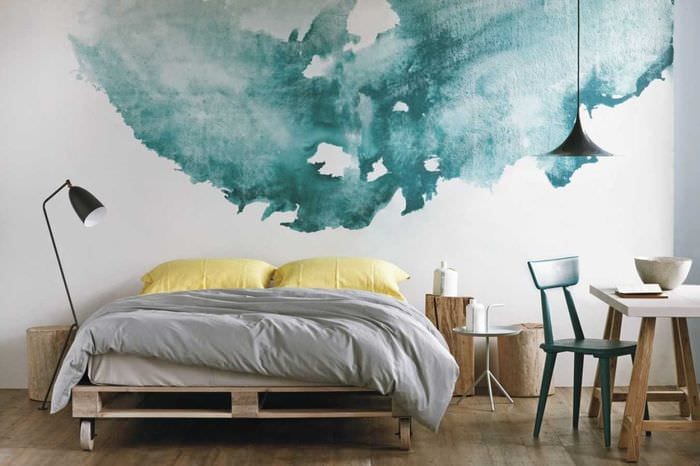
You can also create an original drawing
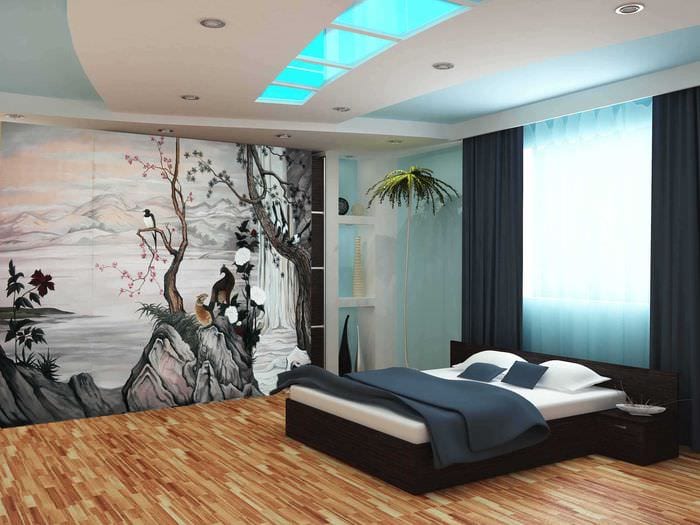
Plants and landscapes are most appropriate in the bedroom
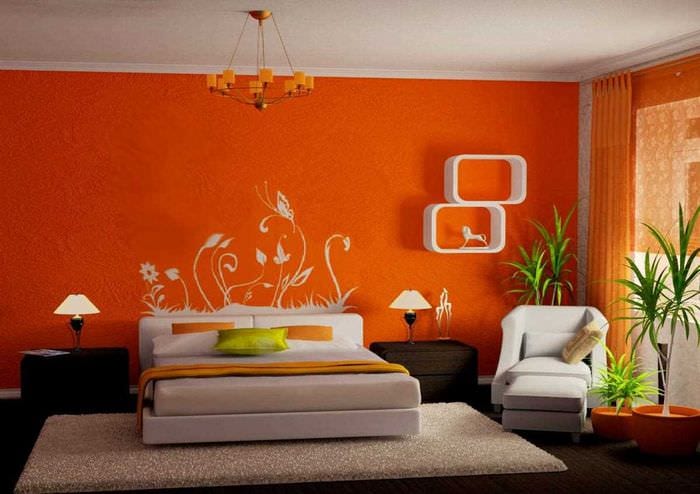
For the bedroom it is better to use calm shades
| Image | What does it symbolize |
| Blooming trees and peonies | Powerful love amulet |
| Butterflies | Amulet of happiness and love. The nuance here is the obligatory presence of a pair of butterflies. |
| Pair of birds | Marital fidelity and mutual feelings |
| Pomegranate fruit | Symbol of the imminent arrival of a child in the family |
| Calm sunny landscapes | Symbolizes a calm and measured family life |
See alsoUsing stencils in the interior: photos, varieties
Living room
This room is the main one in the apartment. This is where the family spends most of their time; holidays and receptions are also held. This area should be decorated with picturesque paintings that embody joy and comfort. The best choice may be:
- reproductions of famous paintings;
- natural and seascapes;
- city images;
- abstraction.
Also, when choosing a painting, you should base it on the style of the room:
- for a classic or Victorian style, antique columns overlooking the sea and images of a blooming garden will harmoniously fit into the interior;
- hi-tech or minimalism goes well with black and white abstraction or the look of a modern city;
- for an ethnic style, you should select paintings depending on the country and its culture that you wanted to embody (sakura blossoms for Japanese style, pyramids for Egypt, the Champs Elysees and the triumphal arch for a French interior).
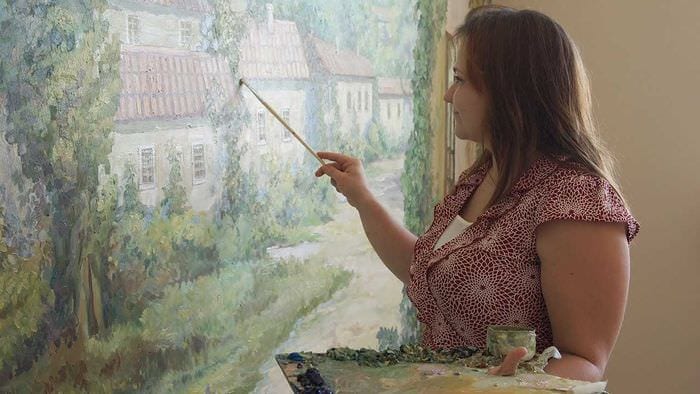
Cityscapes with nature are perfect for the living room
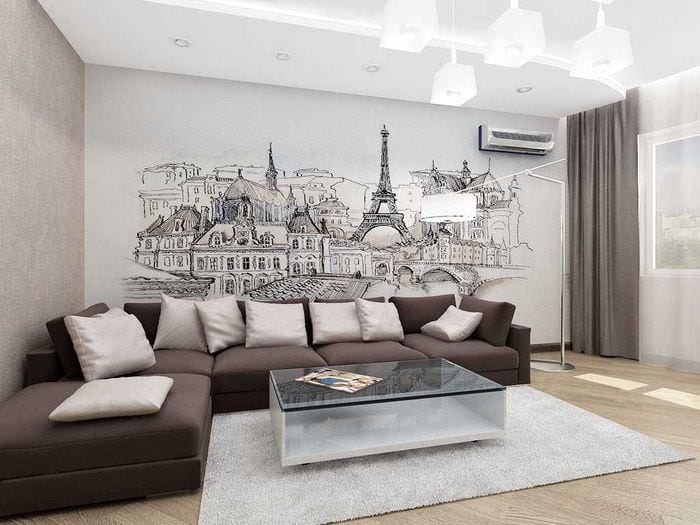
The living room should be decorated with picturesque paintings
See also: Decorating a chest of drawers with your own hands
Kitchen and dining room
The nuance of wall painting in the kitchen interior is the choice of its location. You should not paint the wall near the sink or stove. Constant contact with water and temperature changes can negatively affect wall paintings. If this arrangement is important for the kitchen owner, you should choose moisture-resistant paints for the job, and also coat the creation with several layers of varnish.
To visually expand the room, a landscape, an imitation window or a picnic in nature are perfect. These are the most popular design techniques.
If the goal of interior wall painting is to create a specific atmosphere, the optimal solution may be:
- Still life;
- Image of a dining area in a cafe or restaurant;
- Coffee fantasies and paintings with berries and fruits.
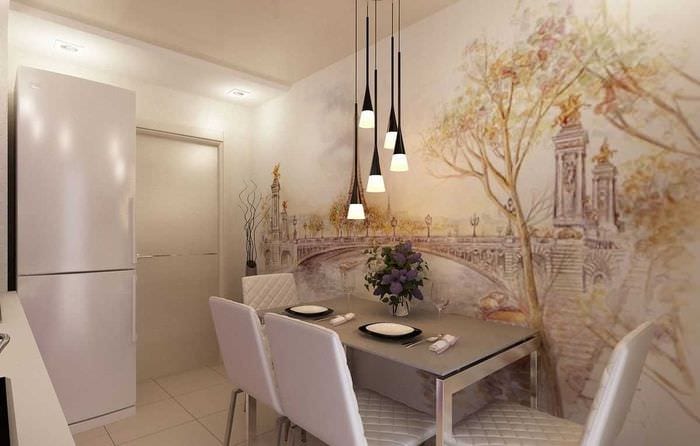
After application, the drawing should be treated with protective agents.
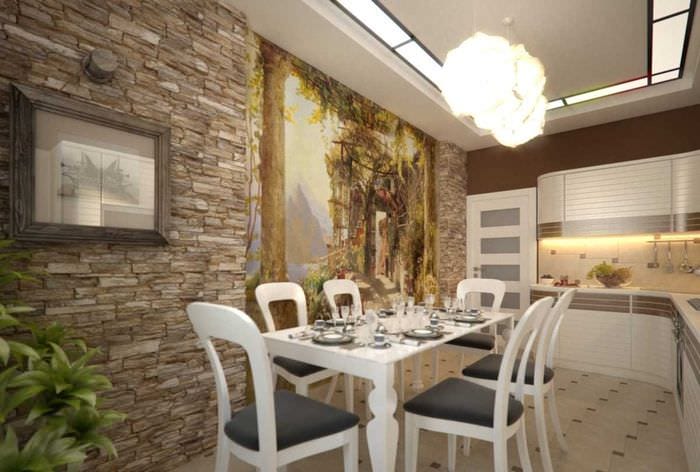
Landscapes are perfect for the kitchen
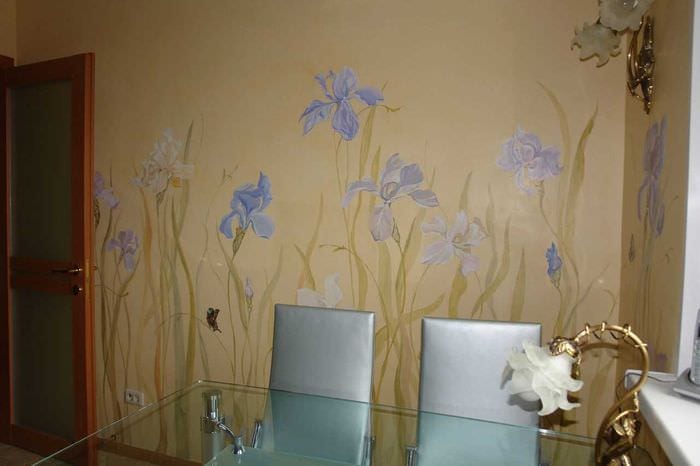
The drawing should be applied on a wall where there is no furniture
See alsoCreate room decor with your own hands from scrap materials
Bathroom
The main factor that stops customers from painting walls in the interior of a bathroom is the increased humidity of the room and regular contact of the walls with steam. These aspects can significantly spoil a wall creation, but modern techniques and materials make it possible to avoid such negative aspects. In such situations, you must adhere to the following rules.
- Use moisture-resistant plaster.
- The work is carried out with special moisture-resistant paints.
- Cover the painting with several layers of protective varnish.
By following all these rules, the drawing will serve its owner for many years without losing its aesthetic properties.
An original solution for the bathroom would be an image of the seabed on the walls along with its inhabitants.
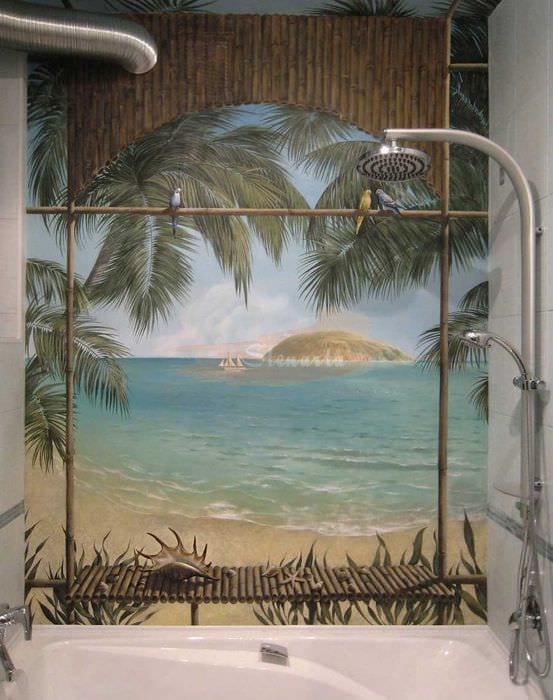
Drawings with a marine theme are suitable for the bathroom.
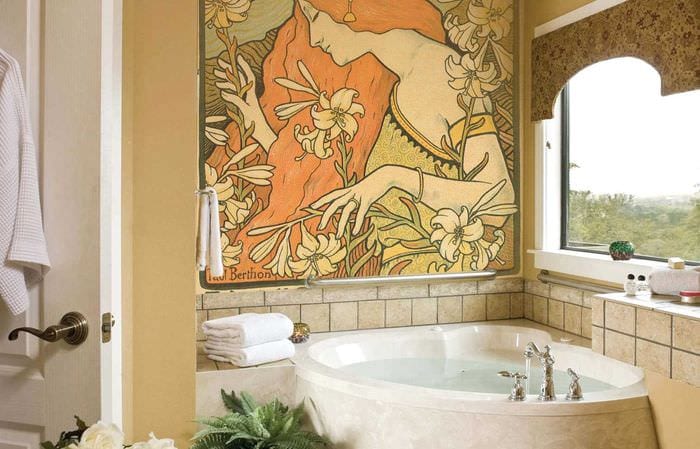
The drawing in the bathroom should be treated with protective agents
See alsoCandle decor - hobby and interior decoration
Children's room
Flights of fancy for painting walls in a children's interior are not organic. When choosing a design style, you should consult with the young owner of the apartment. Wall painting can turn a room into a fairy tale, creating an atmosphere of magic.
From a psychological point of view, you should not use aggressive images and flashy colors for wall painting in a children's room. Here you can use:
- underwater landscapes;
- fairy forest with fairies and animals;
- magical castles;
- cartoon characters and landscapes.
It is worth giving preference to calm and neutral colors for the wall background, but the characters themselves can be drawn in a bright and expressive style.
See also: Choosing decorative plaster is a smart decision


